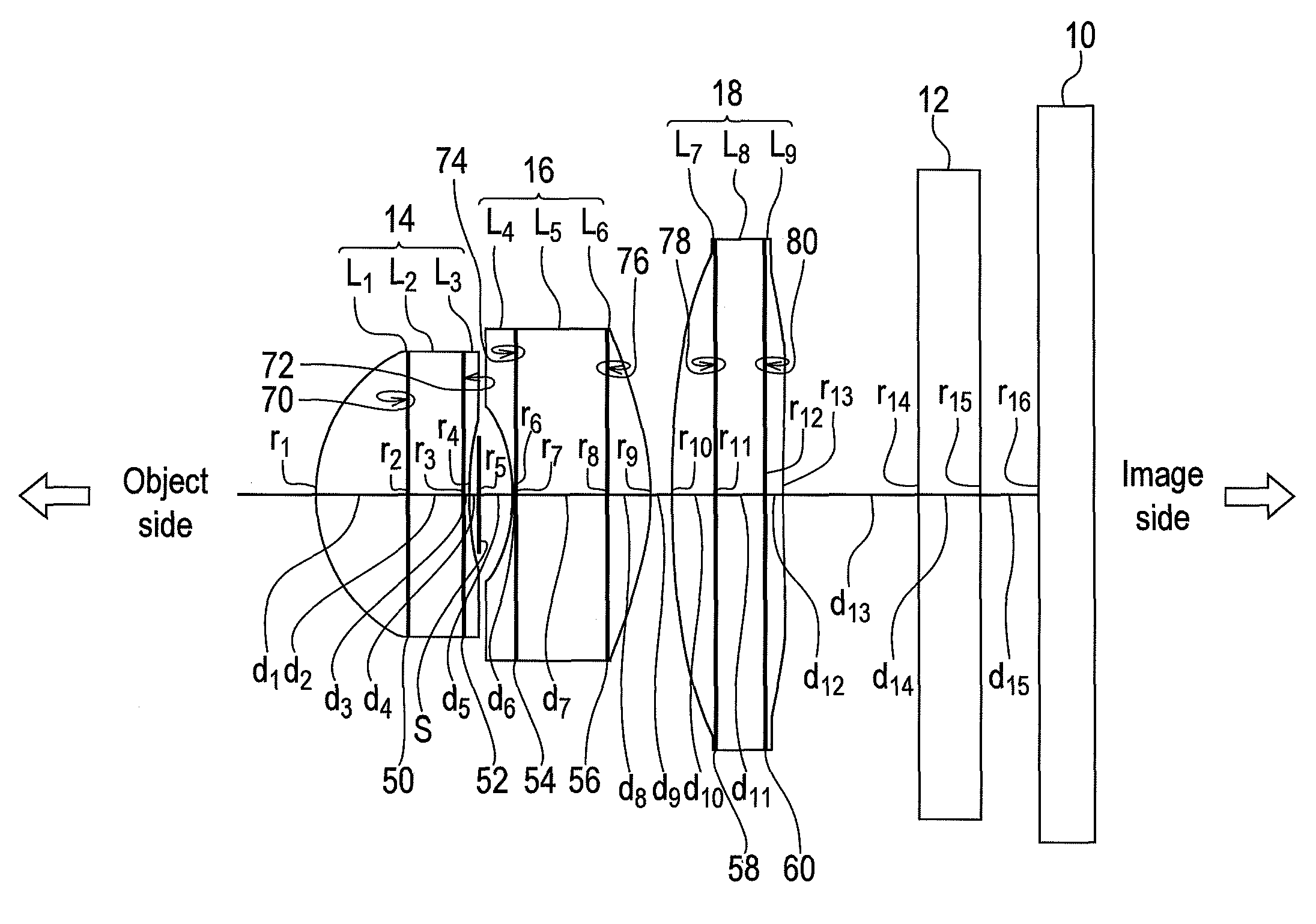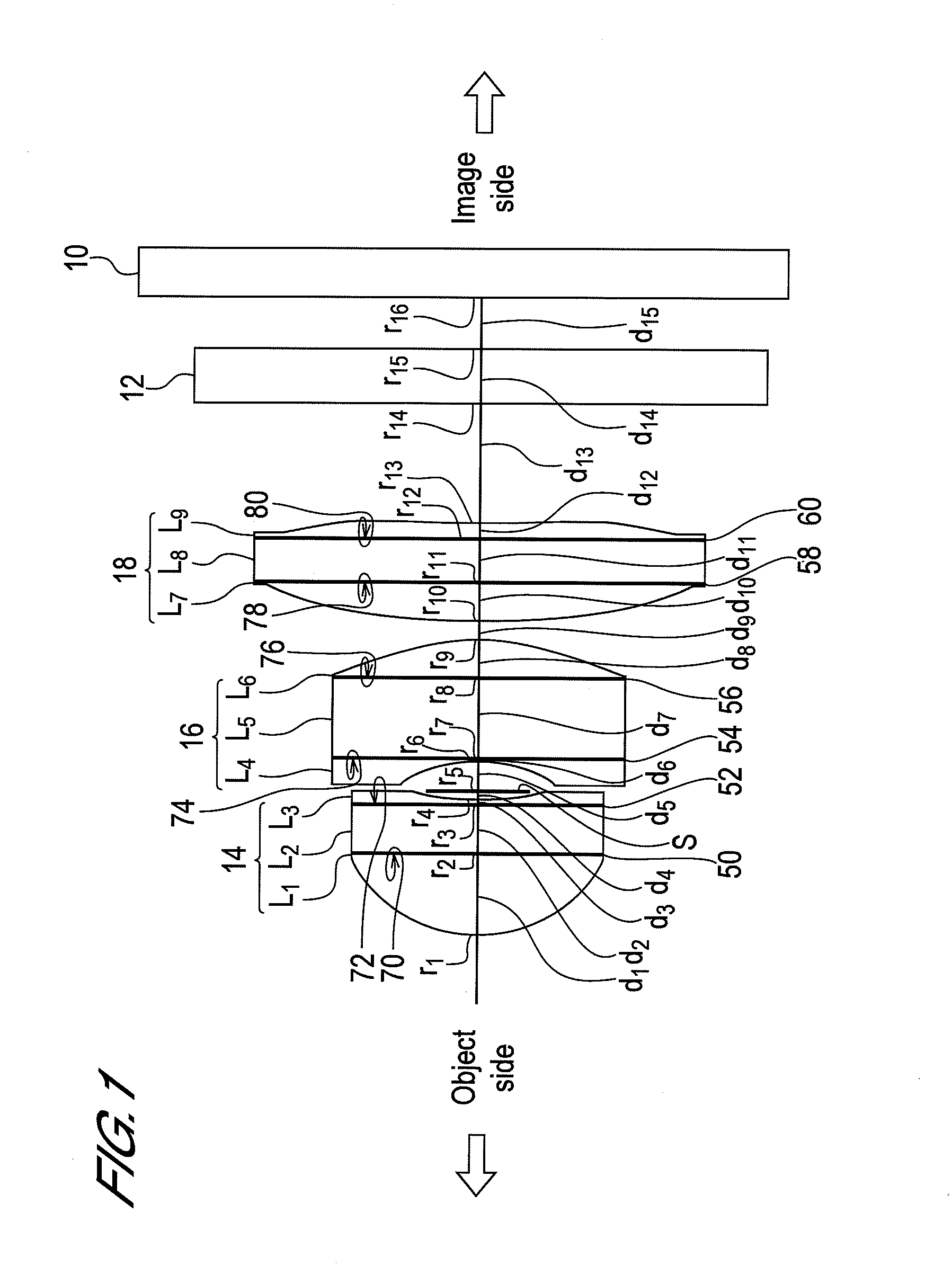Imaging lens
a technology of imaging lens and optical glass, which is applied in the field of imaging lens, can solve the problems of increasing manufacturing cost, complicated manufacturing steps, and inability to maintain optical performance, and achieves the effects of high softening temperature, high softening temperature optical glass material, and high softening temperature optical
- Summary
- Abstract
- Description
- Claims
- Application Information
AI Technical Summary
Benefits of technology
Problems solved by technology
Method used
Image
Examples
embodiment 1
[0187]Embodiment 1 is an embodiment of the first imaging lens of the present invention, where the first lens L1, the third lens L3, the fourth lens L4, the sixth lens L6, the seventh lens L7 and the ninth lens L9 are formed of transparent curable silicone resin SMX-7852 (made by Fuji Polymer Industries Co. Ltd.), and the second lens L2, the fifth lens L5 and the eighth lens L8 are formed of optical glass BK7 (made by Ohara Inc.).[0188](A) The refractive index N1 of the first lens L1 is N1=1.51000.[0189](B) The refractive index N2 of the second lens L2 is N2=1.51633.[0190](C) The refractive index N3 of the third lens L3 is N3=1.51000.[0191](D) The Abbe number ν1 of the first lens L1 is ν1=56.0.[0192](E) The Abbe number ν2 of the second lens L2 is ν2=64.0.[0193](F) The Abbe number ν3 of the third lens L3 is ν3=56.0.[0194](G) The refractive index N4 of the fourth lens L4 is N4=1.51000.[0195](H) The refractive index N5 of the fifth lens L5 is N5=1.51633.[0196](I) The refractive index N6...
embodiment 2
[0219]Embodiment 2 is an embodiment of the second imaging lens of the present invention, where the first lens L1, the third lens L3, the fourth lens L4, the sixth lens L6, the seventh lens L7 and the ninth lens L9 are formed of a transparent curable silicone resin SMX-7852 (made by Fuji Polymer Industries Co. Ltd.), and the second lens L2, the fifth lens L5 and the eighth lens L8 are formed of optical glass BK7 (made by Ohara Inc.)
[0220]The respective composing materials of the first to the ninth lens are the same as the above mentioned Embodiment 1, therefore |N2−N1|=|N2−N3|=|N5−N4|=|N5−N6|=|N8−N7|=|N8−N9|=0.00633, which satisfies the following Conditions (1), (2), (5), (6), (9) and (10). Also |ν2−ν1|=|ν2−ν3|=|ν5−ν4|=|ν5−ν6|=|ν8−ν7|=|ν8−ν9|=8.0, which satisfies the following Conditions (3), (4), (7), (8), (11) and (12).
[0221]FIG. 7 is a cross-sectional view of the imaging lens of Embodiment 2. As FIG. 7 shows, the first stop S1, to play a role of an aperture stop, is formed at a po...
embodiment 3
[0232]Embodiment 3 is an embodiment of the second imaging lens of the present invention, wherein the first lens L1, the third lens L3, the seventh lens L7, and the ninth lens L9 are formed of transparent curable silicone resin SR-7010 (made by Dow Corning Toray Co., Ltd.), the second lens L2 and the eighth lens L8 are formed of optical glass BK7 (made by Ohara Inc.), and the fifth lens L5 is formed of optical glass E-F5 (made by Hoya Corp). And the fourth lens L4 and the sixth lens L6 are formed of transparent curable silicone resin SMX-7877 (made by Fuji Polymer Industries Co. Ltd)).[0233](A) The refractive index N1 of the first lens L1 is N1=1.53000.[0234](B) The refractive index N2 of the second lens L2 is N2=1.51633.[0235](C) The refractive index N3 of the third lens L3 is N3=1.53000.[0236](D) The Abbe number ν1 of the first lens L1 is ν1=35.0.[0237](E) The Abbe number ν2 of the second lens L2 is ν2=64.0.[0238](F) The Abbe number ν3 of the third lens L3 is ν3=35.0.[0239](G) The ...
PUM
 Login to View More
Login to View More Abstract
Description
Claims
Application Information
 Login to View More
Login to View More - R&D
- Intellectual Property
- Life Sciences
- Materials
- Tech Scout
- Unparalleled Data Quality
- Higher Quality Content
- 60% Fewer Hallucinations
Browse by: Latest US Patents, China's latest patents, Technical Efficacy Thesaurus, Application Domain, Technology Topic, Popular Technical Reports.
© 2025 PatSnap. All rights reserved.Legal|Privacy policy|Modern Slavery Act Transparency Statement|Sitemap|About US| Contact US: help@patsnap.com



